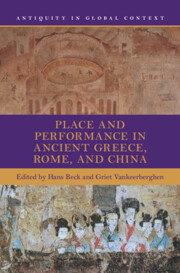Book contents
- Place and Performance in Ancient Greece, Rome, and China
- Antiquity in Global Context
- Place and Performance in Ancient Greece, Rome, and China
- Copyright page
- Contents
- Figures
- Tables
- Contributors
- Series Editors’ Preface
- Editors’ Preface
- Introduction
- Part I Crafting Space and Place
- Part II Performances of Power
- Part III Urban Places
- Part IV Fringe Places and Endpoints
- Index
- References
Part II - Performances of Power
Published online by Cambridge University Press: 28 November 2024
- Place and Performance in Ancient Greece, Rome, and China
- Antiquity in Global Context
- Place and Performance in Ancient Greece, Rome, and China
- Copyright page
- Contents
- Figures
- Tables
- Contributors
- Series Editors’ Preface
- Editors’ Preface
- Introduction
- Part I Crafting Space and Place
- Part II Performances of Power
- Part III Urban Places
- Part IV Fringe Places and Endpoints
- Index
- References
- Type
- Chapter
- Information
- Place and Performance in Ancient Greece, Rome, and China , pp. 87 - 238Publisher: Cambridge University PressPrint publication year: 2024

